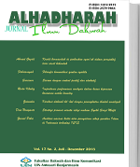Mobile Phone: Sejarah, Tuntutan Kebutuhan Komunikasi, Hingga Prestise.
DOI:
https://doi.org/10.18592/alhadharah.v15i30.1222Keywords:
communication, telecommunication, cellular phone, technology, komunikasi, telekomunikasi, telepon selular, teknologi.Abstract
Human desire to keep on communicating bulldoze constraints of time and space in turn trigger an attempt to create a tool to bridge the limitations of earlier. The codes are transmitted in the conventional form of simple visual and sound that still leaves human dissatisfaction remote communication (tele-communication), effectiveness and efficiency of the smoke, sound, sign of morse, certainly not yet enough. Jump skip the age, and found the telegraph to the appearance of the phone (cable) ago cordless phone which then called the cell phone (mobile phone) is then transformed into revolution. These evolution then became revolution of functions and capabilities that are owned by the cell phone. The sophisticated of mobile phone technology finaly push it not just as a phone but far beyond that, also its additional functions. Which should be recognized and taken into account is the impact of which was carrying was also becoming more sophisticated.Hasrat manusia untuk tetap dapat berkomunikasi melibas kendala batasan ruang dan waktu pada akhirnya memicu usaha untuk menciptakan alat untuk menjembatani keterbatasan tadi. Kode-kode yang dikirimkan secara konvensional berupa visual dan suara yg sederhana masih menyisakan ketidakpuasan komunikasi jarak jauh manusia, efektifitas dan efisiensi pada asap, bunyi, tanda morse, tentu belumlah cukup. Sedikit melompati masa, lalu ditemukan telegraf hingga kemunculan telepon (kabel) kemudian telepon tanpa kabel yang kemudian disebut ponsel (telepon selular). Evolusi ini kemudian berubah revolusi fungsi dan kemampuan yang dimiliki oleh ponsel. Kecanggihan teknologi mendorongnya menjadi selain fungsi bukan hanya sekadar telepon tapi juga fungsi tambahannya. Kesadaran dan yang perlu dipertimbangkan adalah dampak yang dibawanya pun juga semakin canggih.Downloads
How to Cite
Issue
Section
License
Authors retain copyright and grant the journal the right of first publication, with the work simultaneously licensed under the Creative Commons Attribution-NonCommercial 4.0 International Public License (CC BY-NC 4.0). This license allows reusers to distribute, remix, adapt, and build upon the material in any medium or format for noncommercial purposes only, provided that proper attribution is given to the original creator.







